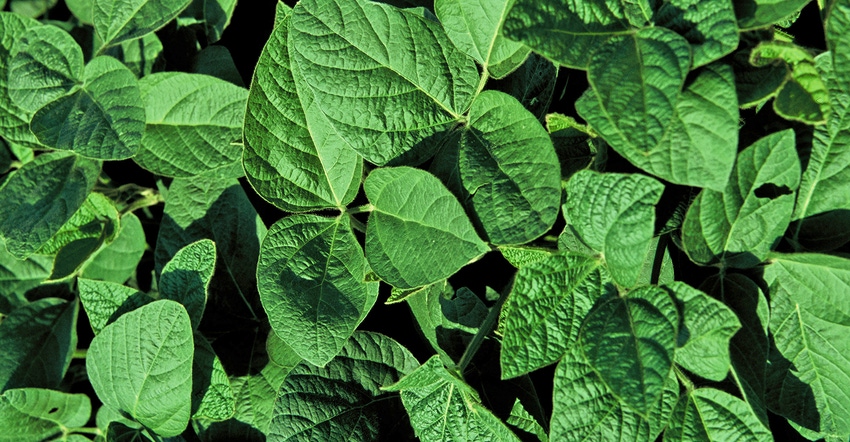August 3, 2018

Often by the time you see white mold symptoms in soybeans it is too late to rescue the crop, but you should take note. There are steps you can take to protect soybeans next year, says Emmanuel Byamukama, South Dakota State University Extension plant pathologist. They include:
1. Cultivar selection. Select cultivars with a tolerance to white mold; some seed companies provide ratings for soybean cultivars against white mold.
2. Crop rotation. Crop rotation helps break the pathogen life cycle. Care should be taken when selecting crops to rotate with soybeans. Most broadleaf crops such as alfalfa, sunflowers and dry beans are also hosts of white mold. Small grains and corn are good non-host crops for white mold. For fields with a history of white mold epidemics, two to three years rotation away from soybeans is recommended. Each year the number of viable sclerotia decreases, especially if the field is under no-till.
3. Deep Tillage. Deep tillage to bury sclerotia helps prevent the sclerotia from developing into mushrooms. However, after deep tillage in subsequent seasons, care should be taken to prevent bringing buried sclerotia back near the soil surface, as buried sclerotia can survive more than three years.
4. Row Spacing. Wide row spacing of more than 20 inches helps delay canopy closure and hence prevents sclerotia from developing into mushrooms. However white mold can develop in wider row spacing if favorable weather is experienced after canopy closure.
5. Avoid Manure. Fertility programs that use animal manure in fields with a history of white mold should be avoided. Animal manure tends to encourage quick lush growth, which favors white mold development.
6. Fungicides. A well-timed fungicide can prevent white mold development. The best timing for fungicide control is R1 (beginning flowering). Use flat-fan spray nozzles to improve mid-canopy coverage. Some of the fungicides with good white mold control include picoxystrobin (Aproach), flutriafol (Topguard), prothioconazole (Proline), tetraconazole (Domark), thiophanatemethyl (Topsin-M, other generics), and boscalid (Endura).
7. Herbicides. Some herbicides with lactofen as the active ingredient such as Cobra are labeled with the language to suggest suppression of white mold. These do not directly inhibit white mold fungus but rather either help open up the plant canopy or delay flowering as well as inducing plants to resist white mold pathogen. The use of these herbicides should be weighed against side effects on the plants such as crop injury from late application.
8. Biological Control. Some biological control agents do provide some level of white mold control. A common commercial biological control agent is Contans. This product is incorporated into the soil in fall or spring. It contains another fungus that feeds on and destroys the white mold sclerotia. There is better control of white mold with repeated use of the product. The effectiveness of this product in managing white mold is not well recorded.
9. Weed Management. Practice good weed control management. Several broadleaf weeds such as lambsquarter, chickweed, field pennycress, velvet leaf and others are all hosts for white mold.
What is white mold?
White mold, also known as Sclerotinia stem rot, is a fungal disease caused by Sclerotinia sclerotiorum. This pathogen survives in soil and in previously infected soybean stems.
White mold symptoms begin after soybean flowering, partly because the white mold pathogen infects through the flower after pollination. Visible canopy symptoms of white mold include grayish green followed by necrosis leading to interveinal yellow blotches. These symptoms can be mistaken for other diseases such as brown stem rot, stem canker or sudden death syndrome. A closer look at infected plants in the middle canopy reveals typical signs of the white mold pathogen, which are white mycelia and the formation of sclerotia on lower stem nodes.
When the soil is moist and shaded from canopy closure or cloudy or foggy weather and temperatures are 40 to 60 degrees F inside the canopy, the sclerotia located within the top 2 inches of top soil germinate into small cup-shaped mushrooms called apothecia. These tiny mushrooms produce millions of spores called ascospores, and when these spores land on senescing flowers under favorable weather conditions, white mold infection is initiated. Spores can be blown by wind more than 160 feet. Senescing flowers provide the nutrient base for infection initiation. Continued colonization of the stems leads to sclerotia production both outside and inside the stem. The new sclerotia will be the source of inoculum for future seasons.
Source: SDSU Extension
You May Also Like




